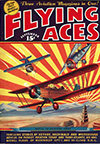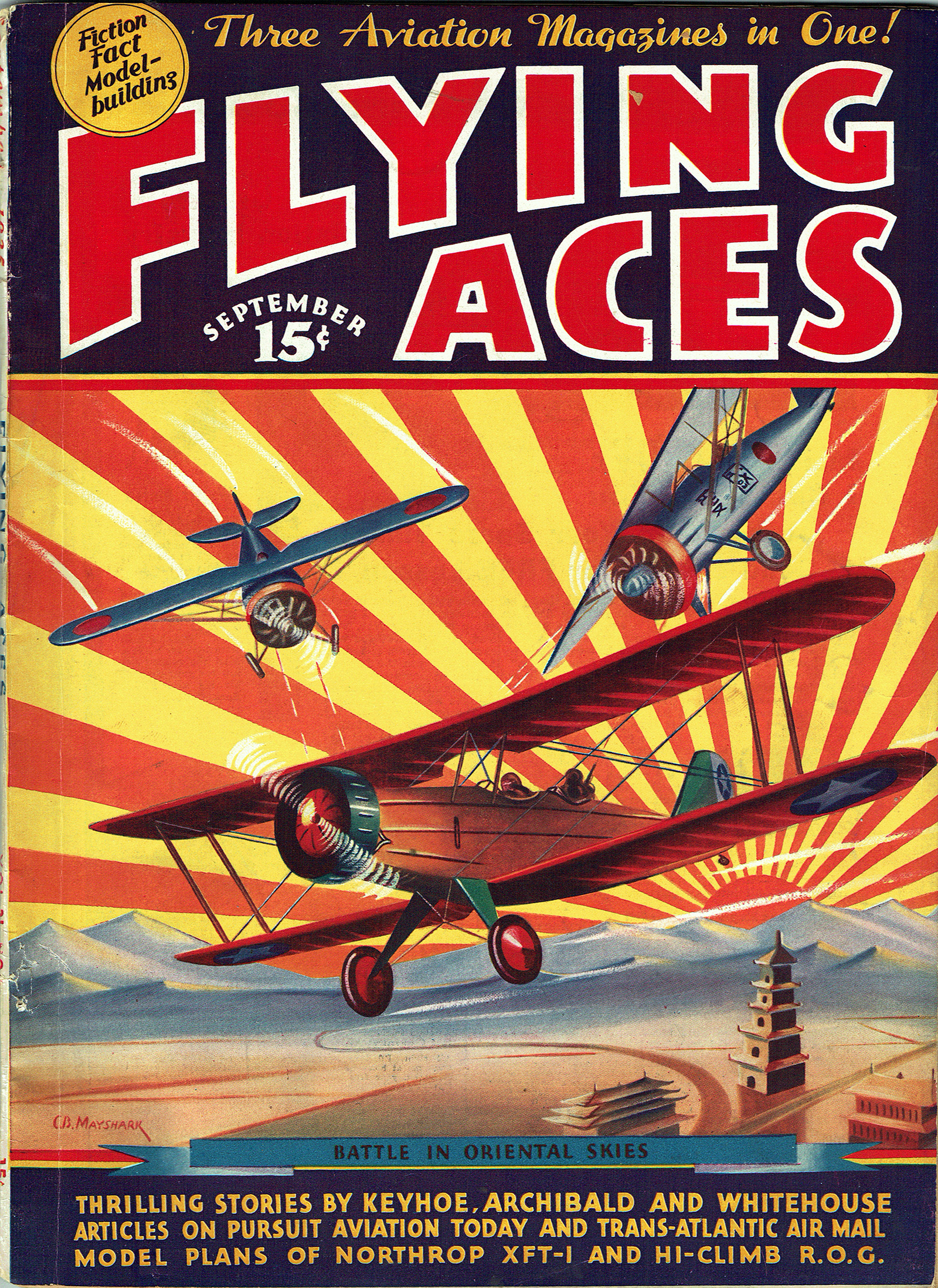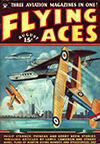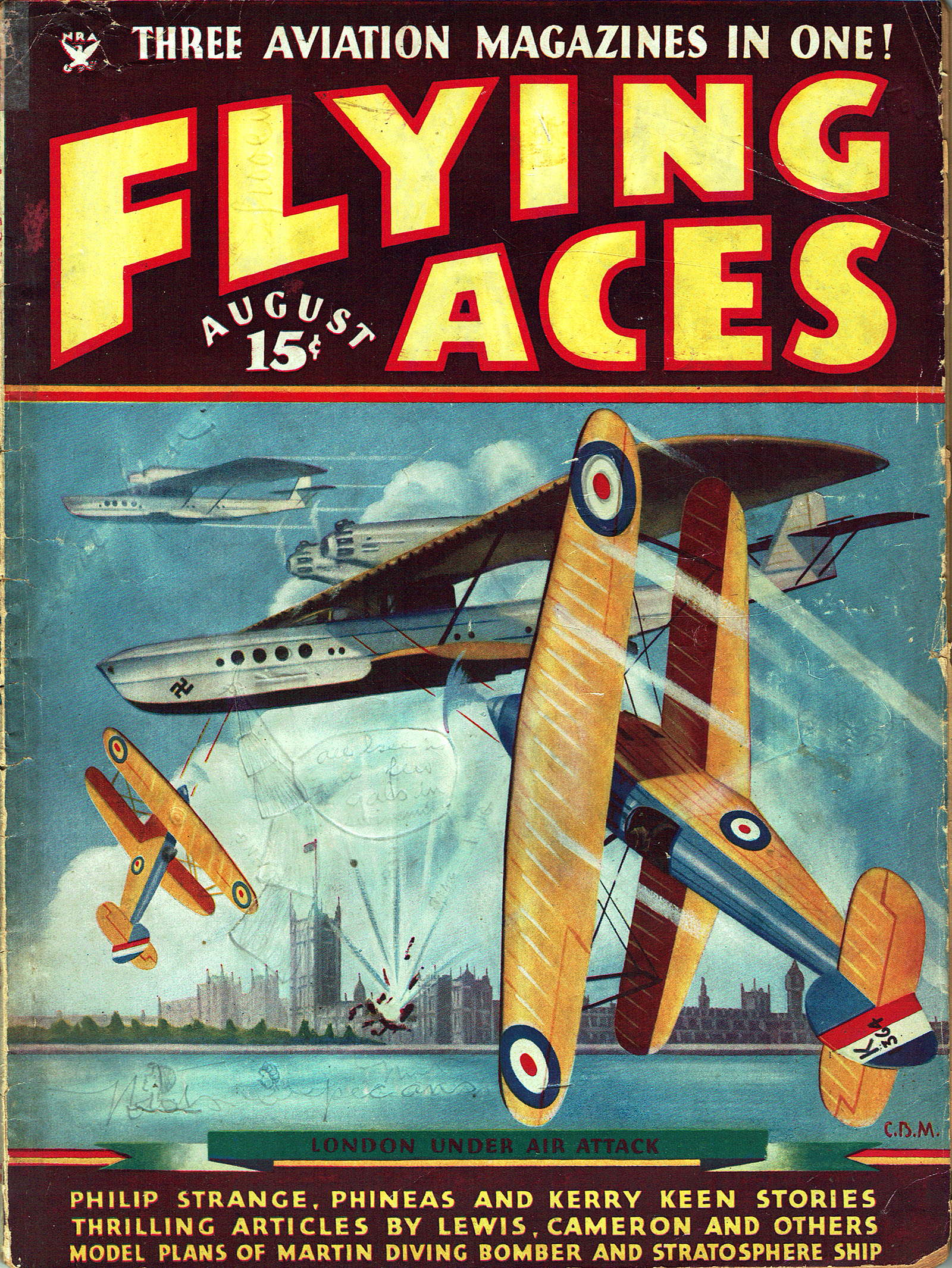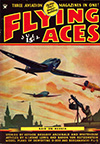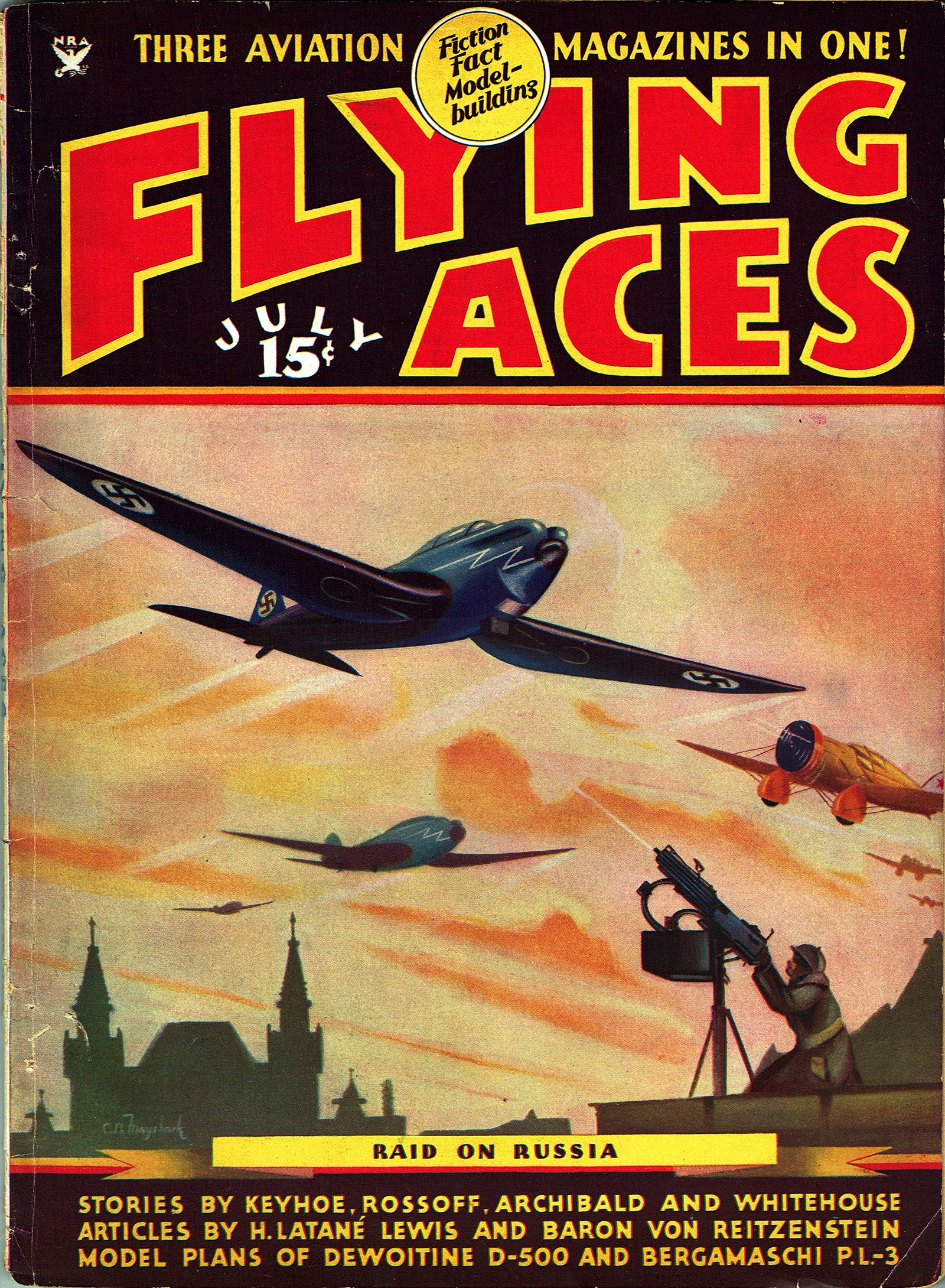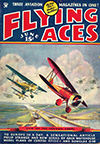“Flying Aces, October 1935″ by C.B. Mayshark
THIS May we are once again celebrating the genius that is C.B. Mayshark! Mayshark took over the covers duties on Flying Aces from Paul Bissell with the December 1934 issue and would continue to provide covers for the next year and a half until the June 1936 issue. While Bissell’s covers were frequently depictions of great moments in combat aviation from the Great War, Mayshark’s covers were often depictions of future aviation battles and planes—like the October 1935 cover where Mayshark gives us a glimpse into a Nazi attack on the Polish Corridor!
Raid on the Polish Corridor
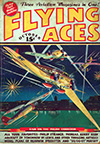 IT IS nearly 2 a.m. in the City of Danzig, and the atmosphere of quiet, common to that hour, prevails. The city’s population is asleep; there is little activity other than the measured steps of the guards and sentinels at the military encampments and fortifications. The night is clear, and a soft, yellow radiance, cast by the moon, is playing over the cold, grey walls of the century-old buildings. Here and there, the darkness is punctuated by the brilliant pin points of the city’s remaining lights.
IT IS nearly 2 a.m. in the City of Danzig, and the atmosphere of quiet, common to that hour, prevails. The city’s population is asleep; there is little activity other than the measured steps of the guards and sentinels at the military encampments and fortifications. The night is clear, and a soft, yellow radiance, cast by the moon, is playing over the cold, grey walls of the century-old buildings. Here and there, the darkness is punctuated by the brilliant pin points of the city’s remaining lights.
It is difficult for one to visualize the fact that this peaceful and slumbering city is one of the storm centers of European diplomatic wrangling. Nazi Germany believes that the city rightfully belongs to her, and if she can’t get it by vote, very likely she will resort to force. Votes, thus far, have failed her.
SUDDENLY an operator on a sound detector at a military flying field springs to attention. Adjusting his earphones, he tunes his instrument to maximum efficiency. Quickly jotting down his observations, he calls a runner and dispatches a note to his superior. A hurried order is broadcast, and a Polish squadron of single-seaters roars into action.
They arrive over the city at a speed of more than two hundred miles per hour—just in time to meet a flight of huge, tri-motored German converted bombers. The Polish pilots must act quickly if Danzig is to be saved. Already, the German ships have begun to drop their deadly eggs, and to make matters worse for the defense ships, a devastating anti-aircraft fire has been leveled at the invaders.
There is a contention among military authorities that it is impossible to completely destroy a city with one air raid, and that one bombing expedition will only serve to bring on a reciprocal one, thus prolonging the warfare. Very likely this logic is good, but it is doubtful if it is applicable in the present case. Danzig, a free city, is under the protectorate of the League of Nations—a body that would find it difficult to conduct retaliatory air raids against Germany. If Germany were successful in taking Danzig by force, she might have a chance of getting away with it, because Poland no longer depends entirely upon that city as a seaport, having recently built her own port at Gdynia, which is located at the Baltic end of the Polish Corridor.
On the other hand, a German air raid on Danzig might only constitute a move to throw Poland off her guard. Once a few bombs were dropped on Danzig, the Nazi bombers could continue southward to attempt devastation of the whole length and breadth of the Polish Corridor.
However, it is logical to assume that Poland would spring to the assistance of Danzig in the manner we have pictured on our cover. Poland, naturally, has an interest in the welfare of Danzig, for she is responsible for the city’s relations with foreign countries. And then, if the German ships were to jump across the border into the Corridor, Poland would find herself in a position to repulse the attack if she had sent defense ships into the air at the first warning of impending danger to the City of Danzig.
And so, with the shrieking of shrapnel and the whine of machine gun bullets the populace of Danzig is awakened with a start of horror. The flight of single-seaters is knifing down to the attack with a vengeance, and the formation of the bombers is temporarily broken. As a rain of tracer is directed against the first German ship, the Polish single-seaters swerve to the side abruptly. Bombers always have been difficult to shoot down, and the defense pilots are finding that their fire is ineffective. It is hard to find a vulnerable spot on such a large surface as that possessed by a tri-motored bomber, much less crash it to the earth with a single burst of bullets. As the defense ships roar in, the anti-aircraft fire abates somewhat in order that the defense ships will not be endangered.
Like a pack of yelping dogs, the gull-winged fighters cut loops of fury in the night sky. Three or four converge on one bomber, and after repeated thrusts it goes down, to crash with a deafening concussion on the earth below. And now two fighters follow it, victims of streaming lead from a vengeful bomber.
The Nazi bombing group now re-forms quickly. With the single-seaters still yelping about their ears, they climb for altitude and leave the city.
What is their purpose? Will they continue on and destroy Gdynia? Or are they merely temporarily pulling away from the scene of battle in order that they can reorganize and return in a short time to finish the job which they have only begun?
The scene that they leave behind is not pleasant to look upon. Everything is stark horror on the streets of Danzig. Mutilated bodies and piles of debris lie grotesquely about the city. Police emergency squads are carrying the wounded and dying to hospitals, and the streets are being cleared of the wreckage. Already, the work of rehabilitation has begun.
Everything being considered, Danzig has not suffered as badly as one might imagine. Comparing the potential destructive force of each bomb dropped, with the actual damage done, it is not difficult to share the belief that it is well nigh impossible to completely annihilate a sizable city with one raid.
And so, Nazi Germany has started on a rampage of conquest, fictitiously, of course. And thus history repeats itself. Governments whose positions have become jittery and insecure domestically have almost invariably attempted to excuse their existence by a successful campaign for territorial annexation. In the long run, however, such governments are doomed to destruction.
THE German ships pictured on this month’s cover are Junkers JU. 52/3m’s. They are tri-motored bombers capable of making 177 miles per hour and having a disposable load of 8,360 pounds. They are powered with three B.M.W. “Hornet†T.I.C. engines. Of course, these planes were designed for freight and passenger service, but the job of converting them into high-efficiency modern bombers would require only a few hours. As a matter of fact, it has already been done, and one ship has been named the “Baron Manfred von Richthofen.â€
The Polish ship used is a P.Z.L. P-XI with a Bristol Mercury IV.A. radial engine fitted with a Townsend low-drag ring cowling. It has a high speed of 217 miles per hour. Poland is known to possess several types of remarkably efficient ships, and the strides she has made in airplane manufacture is all the more remarkable in that every ship in service in that country is of Polish manufacture.
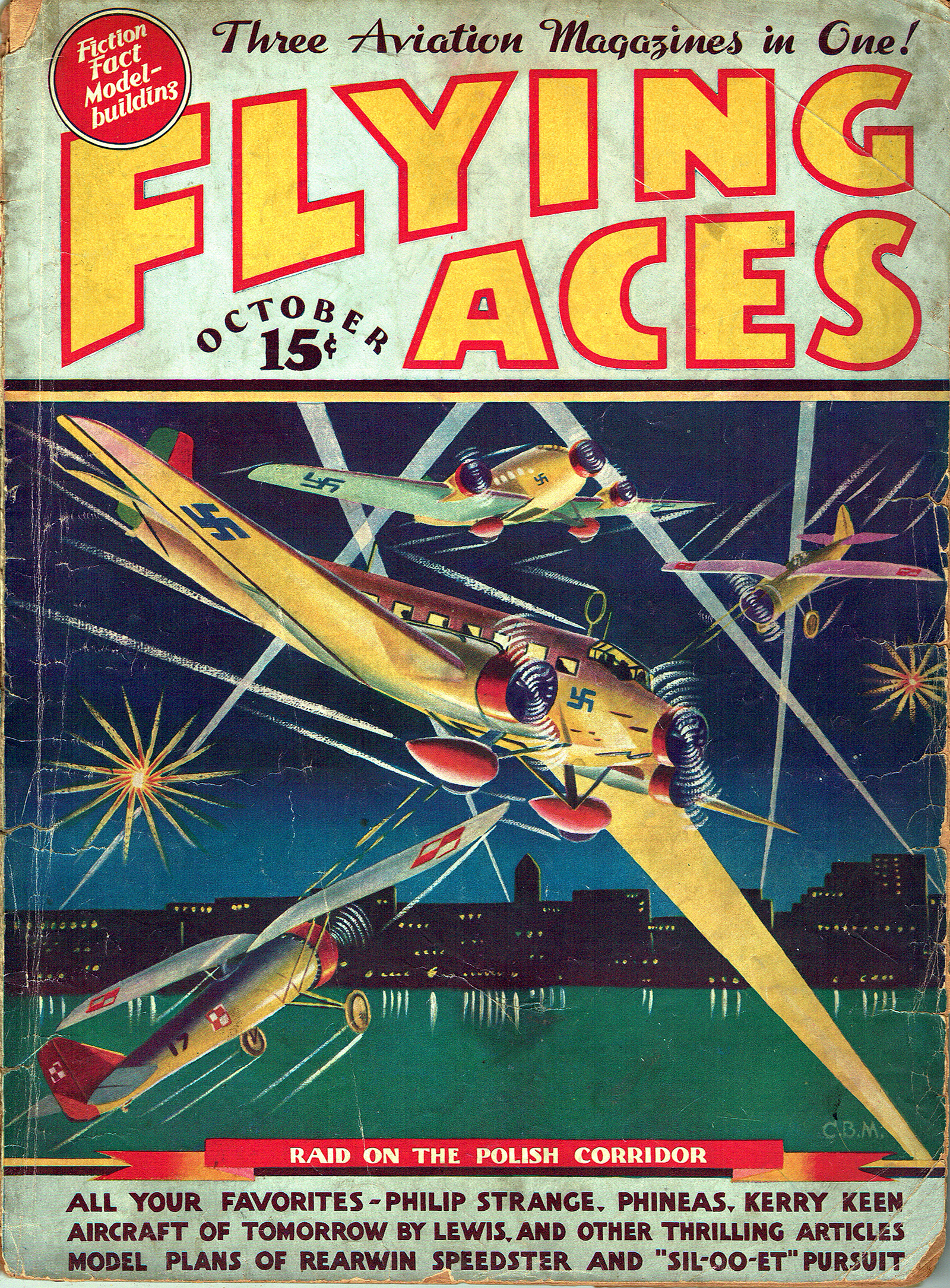
Flying Aces, October 1935 by C.B. Mayshark
Raid on the Polish Corridor: Thrilling Story Behind This Month’s Cover





